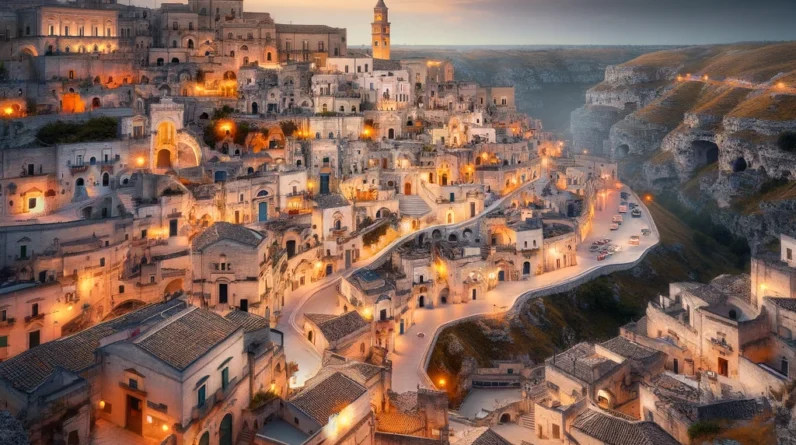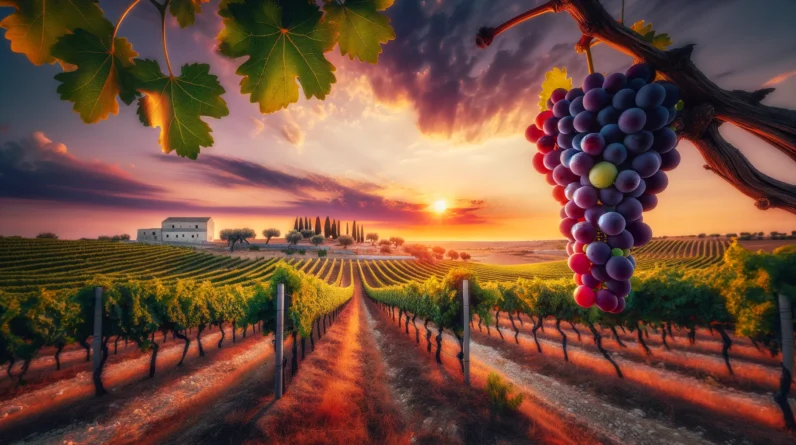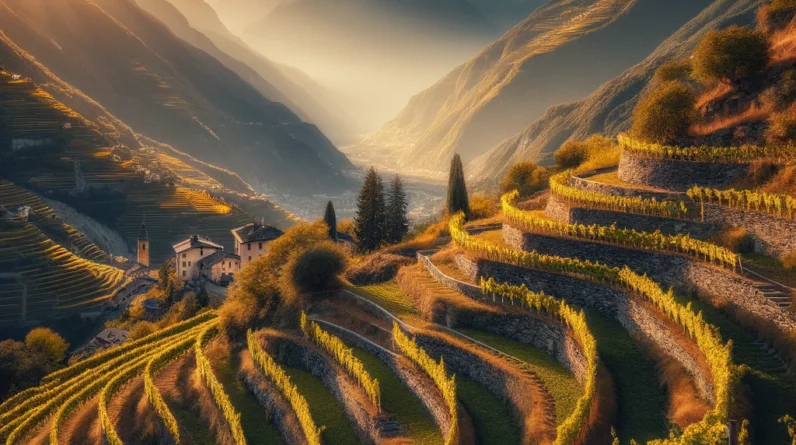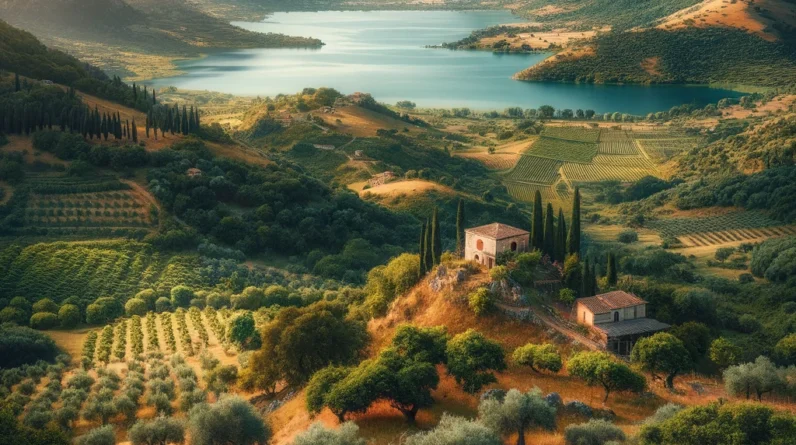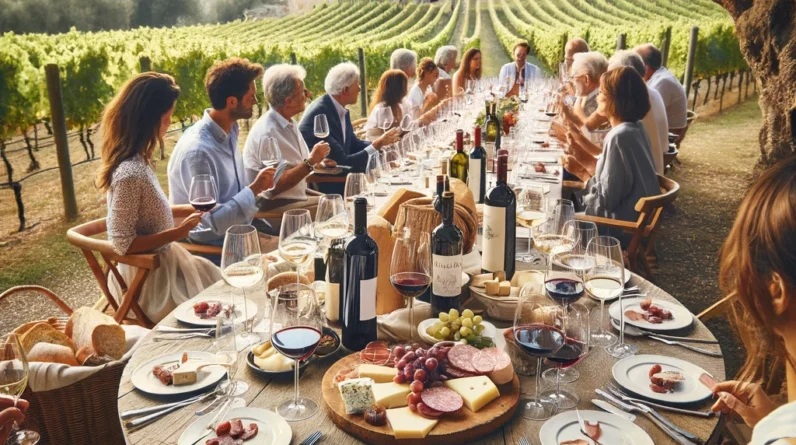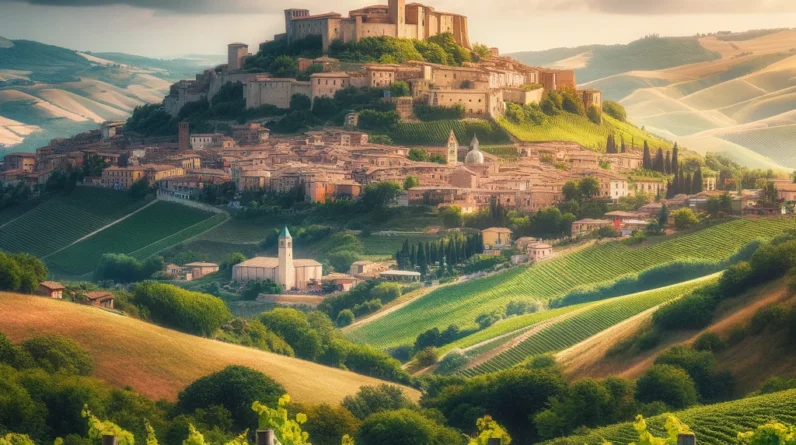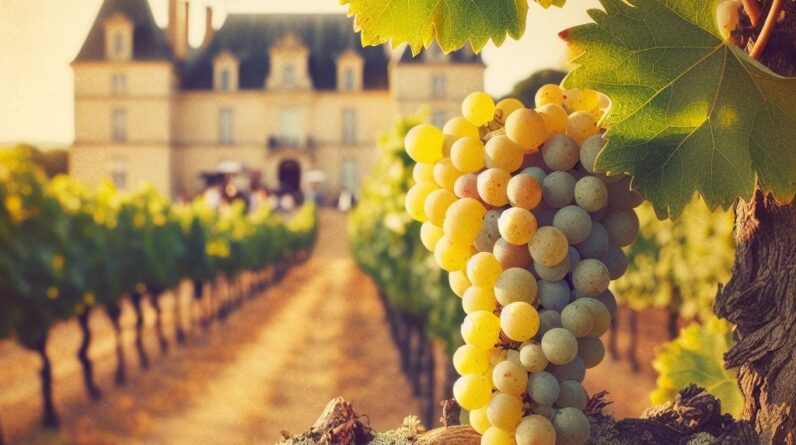
Exploring the Wines and Vineyards of Margaux: A Journey Through Taste and Tradition
Nestled in the heart of Bordeaux, France, lies Margaux, a name that resonates with an air of aristocracy in the wine world.
This revered appellation, a symbol of excellence and tradition, invites connoisseurs and curious explorers alike to delve into its rich tapestry.
In this article, we embark on a journey through Margaux, exploring the nuanced elegance of its wines, the historic vineyards that paint its landscape, and the intricate art of winemaking that has
been honed over centuries.
Whether you’re an avid wine enthusiast or a newcomer to the world of fine wines, Margaux’s story is one of passion, refinement, and an enduring legacy that continues to captivate and inspire.
Join us as we unveil the myriad facets of this esteemed region, from the vine to the glass, and discover why Margaux remains a jewel in the crown of Bordeaux.

The Essence of Margaux
Margaux, a jewel in the crown of Bordeaux, France, is synonymous with elegance in the world of wines.
The wines here are primarily red, with Cabernet Sauvignon leading the blend, supported by Merlot, Cabernet Franc, and Petit Verdot.
What sets Margaux wines apart?
It’s their remarkable balance.
These wines blend power with finesse, offering a silky texture and complex flavors that evolve with age.
Key tasting notes include ripe blackberry, cassis, violets, and often a hint of earthiness or cedar.
Aging potential is another hallmark; top vintages can develop beautifully over decades, making them sought after by collectors.
The Terroir
Margaux, a name that evokes grace and sophistication in the world of wine, is not just a region; it’s a testament to the art of winemaking.
Located in the Left Bank of Bordeaux, France, Margaux’s terroir is a magical combination of geological and climatic elements, contributing profoundly to the identity of its wines.
The Grapes: A Palette of Flavors
Margaux is primarily known for red wines, with a focus on Bordeaux’s classic red grape varieties.
The grape varieties here are the cornerstone of Margaux’s identity.
Dominated by Cabernet Sauvignon, the king of grapes in this region, Margaux’s vineyards weave in other varieties like Merlot, Cabernet Franc, and Petit Verdot.
Cabernet Sauvignon imparts structure and longevity, while Merlot adds softness and fruitiness.
Cabernet Franc contributes a subtle spice and vigor, and Petit Verdot, though used sparingly, adds color and a tinge of floral notes.
| Grape Variety | Flavor Profile | Usage in Margaux | Type (Red/White) |
|---|---|---|---|
| Cabernet Sauvignon
| Blackcurrant, black cherry, cedar, tobacco, green pepper | Primary grape in most blends, adds structure and tannins | Red |
| Merlot
| Plum, blackberry, chocolate, bay leaf, vanilla | Adds roundness, softness, and fruitiness to blends | Red |
| Cabernet Franc
| Raspberry, bell pepper, violet, graphite, herbaceous notes | Used in blends for aroma and acidity | Red |
| Petit Verdot
| Blueberry, violet, ink, leather, spices | Added in small quantities for color, tannin, and flavor intensity | Red |
Margaux does not traditionally focus on white grape varieties, as the region is renowned for its red wines.
The grapes listed above are key to producing the complex, elegant, and age-worthy red wines for which Margaux is famous.
Soil: The Foundation of Character
Margaux’s soils are diverse, yet they share a common trait – they are predominantly gravelly.
This gravel, mixed with sand and clay, plays a pivotal role.
It provides excellent drainage, forcing the vines to grow deep roots, stressing them just enough to produce grapes of intense flavor and complexity.
The gravel also retains heat, helping in the ripening of grapes, a crucial factor in this relatively cooler region.
Climate: A Balancing Act
Margaux’s climate is quintessentially maritime, influenced by its proximity to the Gironde estuary.
This proximity moderates temperatures, creating a microclimate that is slightly warmer than its neighboring areas.
The warm summers and mild autumns contribute to a long growing season, crucial for the slow, even ripening of grapes.
However, this climate also brings challenges, such as humidity and the risk of frost or hail, requiring meticulous vineyard management.
The Margaux appellation is a world where the land speaks through the wine.
Each bottle is a story of its terroir, a narrative told through the grapes, the soil, and the climate.
It’s a region that doesn’t just produce wine; it crafts legacies, with each vintage a new chapter in its enduring saga.
Margaux stands not just as a region but as a symbol of winemaking excellence, where nature and human skill harmonize to create wines that are celebrated across the globe.

Vineyard Visits: A Journey Through the Heart of Margaux
Visiting the vineyards of Margaux is a sensory and educational experience.
Each estate, or ‘château’, has its own story.
The famous Château Margaux, for instance, is not just a winery; it’s a piece of living history.
The architecture, the vineyards, the cellars – all speak of centuries of winemaking tradition.
Tours often include a walk through the vineyards, an exploration of the cellars, and a tasting session.
Visitors can learn about the terroir, a critical factor that gives Margaux wines their unique character.
The gravelly soil here ensures excellent drainage, contributing to the concentration and quality of the grapes.
The Most Notable Vineyards in Margaux
| Vineyard (Château) | Designation (1855 Classification) | Primary Grape Varieties |
|---|---|---|
| Château Margaux
| Premier Cru (First Growth) | Cabernet Sauvignon, Merlot, Cabernet Franc |
| Château Palmer
| Troisième Cru (Third Growth) | Merlot, Cabernet Sauvignon, Petit Verdot |
| Château Rauzan-Ségla
| Deuxième Cru (Second Growth) | Cabernet Sauvignon, Merlot |
| Château Rauzan-Gassies
| Deuxième Cru (Second Growth) | Cabernet Sauvignon, Merlot, Cabernet Franc |
| Château Lascombes
| Deuxième Cru (Second Growth) | Merlot, Cabernet Sauvignon, Petit Verdot |
| Château Brane-Cantenac
| Deuxième Cru (Second Growth) | Cabernet Sauvignon, Merlot, Cabernet Franc |
| Château Durfort-Vivens
| Deuxième Cru (Second Growth) | Cabernet Sauvignon, Merlot |
| Château Ferrière
| Troisième Cru (Third Growth) | Cabernet Sauvignon, Merlot, Petit Verdot |
| Château Desmirail
| Troisième Cru (Third Growth) | Cabernet Sauvignon, Merlot, Petit Verdot |
| Château Marquis d’Alesme
| Troisième Cru (Third Growth) | Cabernet Sauvignon, Merlot, Petit Verdot |
This table represents only a fraction of the esteemed vineyards in Margaux, focusing primarily on those classified in the 1855 Bordeaux Wine Official Classification.
The primary grape varieties listed are those most commonly associated with each estate, though the exact blend can vary by vintage and winemaking practices.
Margaux is renowned for its Cabernet Sauvignon-dominated blends, which are complemented by Merlot, Cabernet Franc, and occasionally Petit Verdot, lending complexity and depth to the wines.

Identity of Margaux
Margaux wines hold a special place in the world of fine wines for several reasons, each contributing to their esteemed reputation.
Elegant and Complex Flavor Profile
Margaux wines are renowned for their exceptional balance and elegance.
They typically exhibit a complex bouquet of aromas, including dark fruits like blackcurrant and blackberry, complemented by subtle floral notes, such as violets.
As they age, these wines develop nuanced flavors including hints of earth, tobacco, and cedar.
Unique Terroir
The Margaux appellation benefits from a unique terroir that significantly influences the quality of its wines.
The region’s gravelly soils provide excellent drainage, encouraging deep root growth which contributes to the concentration of flavors in the grapes.
This terroir, combined with the maritime climate, creates ideal conditions for the slow, balanced ripening of grapes.
Diverse Blends with Dominant Cabernet Sauvignon
While Cabernet Sauvignon is the dominant grape in Margaux wines, contributing structure and longevity, the blends often include Merlot, Cabernet Franc, and Petit Verdot.
This combination allows for a wide range of wine styles within the appellation, each with its unique character, yet all maintaining the quintessential elegance of Margaux.
Aging Potential
Margaux wines are well-known for their aging potential.
The balance of tannins, acidity, and fruit flavors allows these wines to evolve and develop over many years, often decades.
This aging process enhances the complexity and depth of the wines, making them highly sought after by collectors and wine enthusiasts.
Historical Prestige
Margaux is one of the most prestigious appellations in Bordeaux and the world.
It is home to Château Margaux, one of the five First Growths in the 1855 Bordeaux Classification.
This historical significance and the consistently high quality of wines from this region have cemented Margaux’s reputation as a producer of some of the world’s finest wines.
Sensory Experience and Food Pairing Versatility
The sensory experience of tasting a Margaux wine is often described as harmonious and refined, making these wines highly desirable for special occasions and fine dining.
Their versatility also allows them to pair beautifully with a wide range of cuisines, particularly dishes like red meats, game, and richly flavored cheeses.
In essence, Margaux wines encapsulate the artistry of winemaking, reflecting a deep understanding of the land and the grape, and a commitment to crafting wines that are not just consumed but
experienced.

Winemaking: The Art and Science Behind Margaux Wines
The winemaking process in Margaux combines tradition with modern technology.
The region’s mild climate and long growing season are ideal for grape cultivation.
Harvesting is often done manually to ensure the best fruit selection.
Fermentation and aging practices vary between estates, with many using a combination of new and old oak barrels to achieve the desired flavor profile.
The winemakers in Margaux are artists, skillfully blending different grape varieties to create harmonious and expressive wines.
Here are some key techniques used in Margaux.
Selective Harvesting
Winemakers in Margaux often employ selective and sometimes manual harvesting to ensure that only the best grapes are picked.
The timing of the harvest is crucial and is determined by the ripeness of the grapes, which is assessed by sugar levels, acidity, and tasting the grapes.
Grape Sorting
After harvesting, grapes are typically sorted to remove underripe, overripe, or damaged fruit.
This process can be done manually or with the help of optical sorting technology, ensuring only the highest quality grapes are used.
Controlled Fermentation
Fermentation is carefully controlled in terms of temperature and duration.
Many estates use a combination of traditional large oak vats and modern stainless steel tanks.
Controlling the fermentation process allows winemakers to preserve the characteristic fruit flavors and manage the tannin levels in the wines.
Malolactic Fermentation
This secondary fermentation process is common, where tart malic acid in the wine is converted to softer lactic acid.
This process helps in stabilizing the wine and adding complexity to the flavor profile.
Aging in Oak Barrels
Margaux wines are typically aged in oak barrels.
The use of oak imparts tannins and flavors like vanilla, spice, and toast to the wine.
The choice of new versus old barrels, the type of oak, and the duration of aging vary among producers and contribute significantly to the wine’s final character.
The aging process can last anywhere from 12 to 24 months, depending on the style the winemaker is aiming for.
Blending
After aging, wines from different barrels are often blended.
In Margaux, the blend predominantly features Cabernet Sauvignon, complemented by Merlot, Cabernet Franc, and Petit Verdot.
Blending is a crucial step where the winemaker’s expertise is paramount in determining the proportion of each varietal to achieve the desired balance and complexity.
Bottling and Further Aging
Once the blending is complete, the wine is bottled.
Some Margaux wines can benefit from further aging in the bottle, where they develop additional complexity and bouquet.
Sustainable Practices
Many vineyards in Margaux have embraced sustainable and organic winemaking practices.
These include reducing chemical inputs, managing vineyards in a way that promotes biodiversity, and employing techniques that minimize the environmental impact.
The winemaking techniques in Margaux are as much about science as they are about art.
They reflect a deep understanding of the region’s unique terroir and a commitment to producing wines that are not only of high quality but also true expressions of their origin.
The Rich History and Culture of Margaux
The history of Margaux is deeply intertwined with its wines.
The region’s winemaking heritage dates back centuries, with many vineyards established during the Middle Ages.
The 1855 Bordeaux Classification, which ranked the best wines, brought international fame to Margaux, solidifying its status as a top wine-producing region.
The culture in Margaux revolves around wine.
Annual events, tastings, and festivals celebrate this heritage, drawing wine lovers from around the world.
The châteaux, with their impressive architecture, are not just production sites but symbols of a proud and enduring legacy.

Visiting the Margaux Wine Region
Visiting the Margaux region in Bordeaux, France, offers a wealth of experiences beyond its world-class vineyards and wineries.
The area is rich in history, culture, and natural beauty, making it a delightful destination for travelers.
Here are some special places to see and visit while in the Margaux region.
Château Margaux
A visit to the Margaux appellation would be incomplete without seeing its namesake, Château Margaux.
This iconic estate, known for producing some of the world’s most prestigious wines, boasts a magnificent 18th-century neoclassical architecture.
The estate offers guided tours and tastings by appointment.
Route des Châteaux
This scenic drive through the Médoc peninsula takes you past many of the region’s famous wine estates.
It’s an excellent way to explore the area and admire the beautiful châteaux that dot the landscape.
The Village of Margaux
The charming village of Margaux is worth exploring for its quaint streets, local shops, and cozy restaurants serving regional cuisine.
It’s a perfect spot to immerse yourself in the local culture and enjoy some regional specialties.
Fort Médoc
A historical fortification built in the 17th century to protect the Bordeaux region from invasions via the Gironde estuary.
It’s a UNESCO World Heritage site and offers a glimpse into the military history of the area.
L’Estuaire de la Gironde
The Gironde estuary is one of the defining natural features of the region.
Taking a boat tour or simply walking along its banks offers beautiful views and a chance to appreciate the area’s natural beauty.
The Bordeaux Wine and Trade Museum
While technically in the city of Bordeaux, this museum is a must-visit for wine enthusiasts.
It delves into the history of Bordeaux wine trading and provides insights into the region’s winemaking heritage.
Also in Bordeaux, this is an innovative and interactive museum dedicated to the culture and history of wine.
It offers a comprehensive experience that includes tastings, exhibits, and workshops.
Local Markets and Gastronomic Experiences
Exploring the local markets, like the one in the nearby town of Pauillac, offers a taste of local life and regional products.
It’s also a great opportunity to sample local delicacies and wines.
Cycling Tours
The region is conducive to cycling, with many routes taking you through picturesque vineyards and countryside.
It’s a leisurely way to explore the area and visit multiple wineries.
The Atlantic Coast
A short drive away, the Atlantic coast offers beautiful beaches, fresh seafood, and seaside activities, perfect for a day trip.
Each of these places offers a unique way to experience the Margaux region, combining the enjoyment of its world-renowned wines with the exploration of its rich cultural and natural heritage.
Practical Tips on Visiting the Margaux Region
Visiting the Margaux region can be a delightful experience, but some practical tips can help ensure your trip is as enjoyable and smooth as possible.
Plan and Book in Advance
Many wineries and châteaux in Margaux require advance booking for tours and tastings.
Planning ahead and making reservations is crucial, especially during peak tourist seasons.
Hire a Local Guide or Join a Wine Tour
If you’re unfamiliar with the region or prefer a curated experience, consider hiring a local guide or joining an organized wine tour.
They can provide valuable insights, handle logistics, and often grant access to wineries that aren’t open to the public.
Rent a Car
While there are tours available, having a car gives you the flexibility to explore the region at your own pace.
Remember, though, if you’re planning to taste wines, designate a driver or use a service that provides transportation.
Understand the Appellation System
Familiarize yourself with the Bordeaux wine classification system and the Margaux appellation.
This knowledge will enhance your appreciation and understanding of the wines you taste.
Dress Appropriately
Winery visits often include tours of vineyards and cellars, which can be cool and damp.
Wear comfortable shoes and bring a light jacket, even in summer.
Local Etiquette in Tastings
In wine tastings, it’s acceptable to spit out wine after tasting.
This is standard practice and allows you to taste more wines without overindulging.
Explore the Local Cuisine
Don’t miss out on the local gastronomy.
The region is known for its exquisite food that pairs wonderfully with its wines.
Try visiting local markets, restaurants, and cafes.
Stay in Local Accommodations
From charming bed-and-breakfasts to luxurious châteaux, staying in local accommodations can enhance your experience.
They often offer a more intimate and authentic feel of the region.
Learn Some Basic French
While many people in the wine industry speak English, knowing basic French phrases can be helpful and is appreciated by the locals.
Budget Accordingly
While there are options for every budget, be aware that some experiences, especially in more prestigious châteaux, can be expensive.
Plan and budget your trip accordingly.
Respect the Region’s Traditions and Environment
The Margaux region is steeped in history and tradition.
Show respect for the local customs and the environment during your visit.
Check Opening Times and Local Holidays
French wineries and businesses may have different operating hours than you’re used to, and some may close for local holidays.
It’s wise to check these in advance.
By following these tips, you’ll be well-prepared to fully enjoy everything the Margaux region has to offer, from its world-class wines and beautiful landscapes to its rich cultural heritage.
Food Pairing
The Margaux region, nestled in the Bordeaux area of France, is not only famous for its exquisite wines but also for its rich culinary heritage.
The local cuisine, characterized by hearty and flavorful dishes, pairs beautifully with the complex and elegant wines of Margaux.
Here are some special dishes from the region that harmonize wonderfully with Margaux wines.
Entrecôte à la Bordelaise
A classic Bordeaux dish, this is a rib steak cooked in a rich sauce made from red wine, shallots, herbs, and bone marrow.
The robust flavors of the sauce complement the depth and complexity of Margaux red wines, especially those with a good tannin structure.
Lamproie à la Bordelaise
This is a unique and traditional dish where lamprey, a type of fish, is prepared in a sauce made with leeks, herbs, and a generous amount of red wine.
The dish’s earthy and rich flavors pair well with the aromatic and slightly earthy notes of a mature Margaux.
Canard à l’Orange
A dish that combines the rich taste of duck with the sweetness of orange sauce.
The fatty richness of the duck and the sweet and sour profile of the sauce create a delightful contrast with the structured and fruit-forward Margaux wines.
Cèpes (Porcini Mushrooms) Grilled or in Sauce
The earthy and meaty flavors of porcini mushrooms, either grilled or cooked in a creamy sauce, make an excellent pairing with the silky and complex profile of Margaux wines, highlighting the
wines’ earthy undertones.
Agneau de Pauillac (Lamb from Pauillac)
Lamb dishes, particularly those from the nearby Pauillac region, are a perfect match for Margaux wines.
The tender, flavorful meat of the lamb complements the elegant tannins and rich fruit flavors of the wine.
Fromage de Brebis (Sheep’s Cheese)
The region’s sheep’s cheese, often served with cherry jam, offers a delightful combination of creamy texture and sweet-savory flavors, which pairs splendidly with the softer, more fruit-forward
vintages of Margaux.
Truffles and Truffle-based Dishes
Truffles, with their earthy and intense aroma, are a luxurious addition to many dishes, from simple truffle-infused scrambled eggs to elaborate truffle sauces.
These pair exceptionally well with older vintages of Margaux, which develop earthy and truffle-like notes as they age.
Each of these dishes reflects the gastronomic richness of the Margaux region and provides a harmonious complement to the world-renowned wines produced there.
The pairing of local cuisine with Margaux wines is not just a culinary experience but a celebration of the region’s cultural and gastronomic heritage.
Best Vintages in Margaux
Identifying the best vintages in Margaux is a subject of much interest and discussion among wine enthusiasts and experts.
The quality of a vintage in Margaux, as in other Bordeaux regions, can vary significantly due to climatic variations and winemaking decisions.
However, certain years stand out for producing exceptional wines that showcase the best of what Margaux has to offer.
Here are some of the most acclaimed vintages:
2000: Celebrated as an exceptional year, the 2000 vintage produced wines of great balance, structure, and aging potential.
The growing season was favorable, leading to well-ripened grapes.
2005: An outstanding vintage characterized by its consistent quality across Bordeaux.
The wines from 2005 are known for their depth, concentration, and tannic structure, suggesting a long aging potential.
2009: This vintage is noted for its ripe, opulent, and richly flavored wines.
The growing conditions in 2009 were near-perfect, resulting in wines with excellent balance and complexity.
2010: Similar to 2009, the 2010 vintage in Margaux is highly regarded.
The wines are known for their intense aromas, robust structure, and potential to age gracefully.
2015: This more recent vintage has been praised for producing elegant and well-structured wines.
The favorable weather conditions in 2015 allowed for optimal grape ripening, leading to wines with a good balance of fruit, acidity, and tannins.
2016: The 2016 vintage is also noteworthy, often described as producing wines with excellent depth, vibrancy, and aging potential.
The late-season warmth contributed to the overall quality of the grapes.
2018: This is a more recent vintage that has garnered attention for its high-quality wines.
The warm and dry conditions of the summer resulted in rich, concentrated wines with good aging potential.
It’s important to note that wine preferences can be subjective, and what constitutes a “best” vintage may vary depending on personal taste and the specific characteristics one appreciates in a
wine.
Additionally, the quality of a wine can also depend on the specific winemaking practices and terroir of each château, so there can be variation within a vintage.
Wine enthusiasts often enjoy exploring different vintages to experience the variations and unique qualities each year brings to Margaux wines.
For enthusiasts looking to buy Margaux wines, whether for pleasure or investment, understanding the market is key.
The top vintages command high prices, reflecting their quality and rarity.
However, there are also more accessible options for everyday enjoyment.
When buying, look for reputable retailers or direct purchases from vineyards.
Investing in Margaux wines requires knowledge of vintage quality, market trends, and proper storage conditions.
Well-preserved bottles from exceptional vintages can appreciate in value over time, making them a potentially lucrative investment.
FAQs:
Q1: What makes Margaux wines unique?
A1: Margaux wines are celebrated for their elegance, balance, and complex flavor profiles.
The unique terroir, characterized by gravelly soils and a favorable microclimate, along with the predominant use of Cabernet Sauvignon blended with Merlot, Cabernet Franc, and Petit Verdot, gives
these wines their distinct silky texture, depth of flavor, and excellent aging potential.
Q2: Can I visit vineyards in Margaux?
A2: Absolutely! Many vineyards in Margaux offer tours and tastings.
Visitors can explore historic estates, learn about the winemaking process, and taste different vintages.
It’s advisable to book in advance, as some châteaux require appointments for tours.
Q3: Are Margaux wines expensive?
A3: Margaux wines range in price.
While top vintages from renowned châteaux can be quite expensive, there are also many high-quality options available at more accessible price points.
Prices vary based on the vintage, estate, and rarity.
Q4: What are the best vintages of Margaux wines?
A4: Notable vintages include years like 2000, 2005, 2009, 2010, and 2015, among others.
However, vintage quality can vary, and exploring different years can be a rewarding experience.
Q5: Is Margaux only known for red wines?
A5: Yes, Margaux is predominantly known for its red wines.
The appellation specializes in red Bordeaux blends, primarily using Cabernet Sauvignon, Merlot, Cabernet Franc, and Petit Verdot.
Q6: What food pairs well with Margaux wines?
A6: Margaux wines, with their balanced tannins and complex flavors, pair wonderfully with red meats, game, richly flavored dishes, and mature cheeses.
The wine’s elegance makes it versatile for various culinary pairings.
Q7: How long can I age Margaux wines?
A7: Many Margaux wines, especially from good vintages and reputable estates, have excellent aging potential.
Top wines can age gracefully for decades, developing more nuanced flavors over time.
However, the aging potential varies by vintage and winemaking style.
Q8: What is the significance of the 1855 Classification in Margaux?
A8: The 1855 Classification was a historic ranking of Bordeaux wines, including those from Margaux, for the Paris Exposition.
It classified vineyards into five categories based on quality and price.
This classification still influences the reputation and pricing of Margaux wines today.
Q9: How does the climate in Margaux influence the wines?
A9: The maritime climate in Margaux, with its moderate temperatures and long growing season, allows for the slow, even ripening of grapes.
This results in well-balanced wines with a harmonious blend of fruit, acidity, and tannins.
Q10: Can I find white wines in Margaux?
A10: While Margaux is renowned for its red wines, some producers in the region may also produce white wines, typically under different appellations.
However, these are not as common or as widely recognized as the red wines of Margaux.



